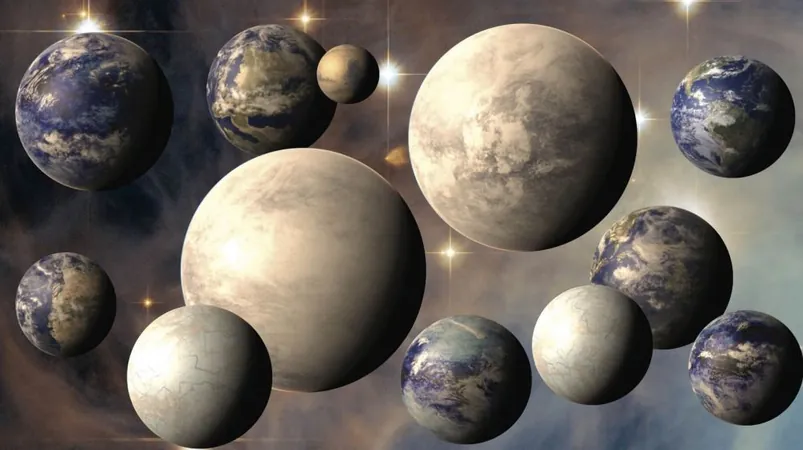
Life's Unlikely Survival: Can Habitable Environments Exist Even in Hostile Conditions?
2024-10-24
Author: Jia
Introduction
From the deserts of Mars to the thick clouds of Venus, the concept of life as we know it is being challenged. Traditional wisdom tells us that life requires water, warmth, and nutrients, leading to what many call the “habitability mantra.” But what if we relaxed these parameters? Could life still thrive in unexpected environments, perhaps even beyond our own Earth?
A Broader Definition of Habitability
As astrobiologists explore the cosmos, they often focus on Earth-like characteristics when searching for signs of life. The current tally of known exoplanets has soared to about 6,000, yet only a handful fit the Earth-like mold. This raises a significant question: if we broaden our definition of habitability, could we discover new potential havens for life?
A groundbreaking study titled "Self-sustaining Living Habitats in Extreme Environments," co-authored by Harvard scientist Robin Wordsworth and University of Edinburgh’s Professor Charles Cockell, offers an intriguing perspective. Their research dives deep into the viability of simple, photosynthetic organisms existing beyond the conventional gravitational boundaries of planets, revealing that life may not need an Earth-like setup to flourish.
Exploring Extremes: Life Beyond Earthlike Definition
The researchers assert that life can indeed exist under a myriad of conditions, provided key elements are in place, particularly the ability of organisms to perform photosynthesis and access sunlight. Dr. Wordsworth notes, “When solar radiation is the energy source, life can flourish over a far larger area than we previously considered.”
While Venus’s surface is inhospitable, scientists speculate that its higher atmospheric layers could harbor unique life-sustaining environments. Similarly, moons like Titan, Europa, and Enceladus have sparked scientific interest due to their subsurface oceans. Although these icy worlds may not provide sunlight for photosynthetic life, they could still support other forms of non-sentient organisms thriving in adapted ecosystems.
Defining the Minimum Requirements for Life
The crux of the debate lies in understanding what complexity is needed for life to sustain itself elsewhere. This unique study conducted by Wordsworth and Cockell examined various factors: from atmospheric pressure to temperature and radiation levels, all of which could influence the emergence of life. They highlighted that photosynthetic-based organisms are particularly appealing models, as they could potentially extend life’s reach into unfamiliar environments.
Critically, the research sought to challenge the notion that life can only evolve in Earth-like conditions. If simple life forms can develop self-contained ecosystems that regulate their habitability, then perhaps life can take root in some of the least likely places in the universe.
Implications for Space Exploration and Terraforming
The consequences of this work stretch beyond extraterrestrial life. It opens doors for human life support on Mars, the Moon, and beyond. Researchers suggest that biotechnology could be harnessed to create synthetic habitats, aiding in habitat construction, food production, and space travel.
Moreover, broadening our understanding of potential life-supporting environments may prompt scientists to rethink their strategies for detecting life. New detection methods will be necessary for environments that defy traditional expectations.
Additionally, delving into how Earth's flora and fauna have shaped its habitability gives insight into possible life-sustaining models in other planetary contexts. This knowledge can inform more ambitious projects like terraforming Mars, where scientists grapple with the possibilities of creating Earth-like conditions.
Conclusion
In summary, the barriers that define habitability are more flexible than previously thought. Research like that from Wordsworth and Cockell not only brightens the prospects for discovering life beyond Earth but also enhances our understanding of life’s resilience in extreme conditions. As we journey further into the cosmos, our definition of habitability is bound to evolve, pushing the frontiers of what is possible. Keep an eye on this fast-moving field; the next great discovery could shake the very foundations of what we consider life!


 Brasil (PT)
Brasil (PT)
 Canada (EN)
Canada (EN)
 Chile (ES)
Chile (ES)
 España (ES)
España (ES)
 France (FR)
France (FR)
 Hong Kong (EN)
Hong Kong (EN)
 Italia (IT)
Italia (IT)
 日本 (JA)
日本 (JA)
 Magyarország (HU)
Magyarország (HU)
 Norge (NO)
Norge (NO)
 Polska (PL)
Polska (PL)
 Schweiz (DE)
Schweiz (DE)
 Singapore (EN)
Singapore (EN)
 Sverige (SV)
Sverige (SV)
 Suomi (FI)
Suomi (FI)
 Türkiye (TR)
Türkiye (TR)